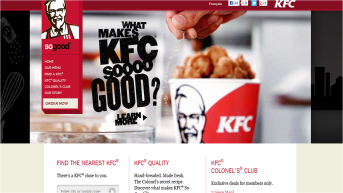In early January 2013, Ibrahim Langoo, a student in Colchester, UK, was eating a chicken piece at a KFC restaurant. While he was picking his chicken apart, he came across what looked like a brain and posted the photo to Facebook, along with the caption, “For all those that wanted to show their friends and families, here is the reason to never go to KFC ever again”. The photo was shared hundreds of times, with comments being made all over social media and resulting in negative publicity for KFC. Langoo also sent the photo to KFC for analysis and a KFC spokesperson replied with, “Although we haven’t received the product, it appears from a photograph that unfortunately on this occasion a kidney, and not a brain as claimed, was not removed in the preparation process. We’re very sorry about Mr Langoo’s experience and while there was no health risk, we agree it was unsightly”. Not much of an apology, is it?
You could view the photo of the brain/kidney and the Sun article here.
KFC did very little mitigate the situation online. Here are three things I would have done to ensure that this situation didn’t have a lasting negative impact on the company while proving that I took my customers’ concerns seriously and was acting to resolve the issue:
1. Monitor and respond on social media
 After the incident was first publicize, KFC did not provide any information regarding the situation on its social media networks, including Twitter and Facebook, preferring instead to post about its current promotions. While these posts were likely scheduled in advance, most of them should have been disabled and someone from the company should have composed at least a couple of original ones. This is something all organizations going through a social media crisis should look at, since according to Melissa Agnes, “Failing to do so will only make your company or organization look insensitive, uncaring and very disorganized”. Posting updates and information on what KFC is doing to ensure this doesn’t happen again would have made a huge difference; at the very least, acknowledgement of the incident would have been a start. Furthermore, they could have used this opportunity to provide a real apology, which brings me to my second point.
After the incident was first publicize, KFC did not provide any information regarding the situation on its social media networks, including Twitter and Facebook, preferring instead to post about its current promotions. While these posts were likely scheduled in advance, most of them should have been disabled and someone from the company should have composed at least a couple of original ones. This is something all organizations going through a social media crisis should look at, since according to Melissa Agnes, “Failing to do so will only make your company or organization look insensitive, uncaring and very disorganized”. Posting updates and information on what KFC is doing to ensure this doesn’t happen again would have made a huge difference; at the very least, acknowledgement of the incident would have been a start. Furthermore, they could have used this opportunity to provide a real apology, which brings me to my second point.
2. Apologize online
 KFC had the opportunity to use this social media crisis to their advantage – by admitting a mistake had been made and it was looking into ways to avoid future ones, the brand could have been strengthened, as has happened in another recent social media crisis. Instead, they decided to ignore social media altogether, preferring to issue a statement to the UK Sun. The statement, which sounds to me like a veiled attempt at an apology and certainly not a heartfelt one, could have been published on their website, too. As for the apology itself, KFC did not take the blame for this grotesque mistake, instead apologizing for Ibrahim’s “experience”, and that although the kidney was “unsightly”, it posed no health risks. Lastly, KFC didn’t actually come out and confirm that it was a kidney (and not a brain), only states that it appears through the photograph to be so. Once it had been tested, an update regarding what the part was could have been posted online (see point #3), along with what KFC would be doing in the future to avoid these types of situations.
KFC had the opportunity to use this social media crisis to their advantage – by admitting a mistake had been made and it was looking into ways to avoid future ones, the brand could have been strengthened, as has happened in another recent social media crisis. Instead, they decided to ignore social media altogether, preferring to issue a statement to the UK Sun. The statement, which sounds to me like a veiled attempt at an apology and certainly not a heartfelt one, could have been published on their website, too. As for the apology itself, KFC did not take the blame for this grotesque mistake, instead apologizing for Ibrahim’s “experience”, and that although the kidney was “unsightly”, it posed no health risks. Lastly, KFC didn’t actually come out and confirm that it was a kidney (and not a brain), only states that it appears through the photograph to be so. Once it had been tested, an update regarding what the part was could have been posted online (see point #3), along with what KFC would be doing in the future to avoid these types of situations.
For the apology to be more real and show that KFC took the matter (pun intended) seriously, it could have had its spokesperson or a more senior executive issue an apology on camera. The video could have then been posted to its website and YouTube, and shared via its various social networks. Lastly, instead of apologizing for Ibrahim’s experience, which seems to shift the blame onto him, they should have apologized for this oversight and admitted it was a mistake on their part.
3. Webpage and updates
 When the story first broke, KFC should have created a webpage on its website specifically to handle this situation. The first post could have acknowledged the incident and stated that KFC is looking into the situation, that it takes Ibrahim’s and the public’s concerns seriously, and the company will provide updates as soon as possible. Subsequent posts could have included the test results (kidney or brain?), a heartfelt apology (see point #2), updates on how KFC is dealing with the situation, and any changes they will be making to their preparation methods. When posting on Twitter and Facebook, they could have linked back to the webpage; users would not only have access to all updates surrounding the incident, but could also visit some of the other sections of the site, potentially resulting in new customers. The webpage could have included contact information should members of the public wish to speak to someone directly to voice their concerns.
When the story first broke, KFC should have created a webpage on its website specifically to handle this situation. The first post could have acknowledged the incident and stated that KFC is looking into the situation, that it takes Ibrahim’s and the public’s concerns seriously, and the company will provide updates as soon as possible. Subsequent posts could have included the test results (kidney or brain?), a heartfelt apology (see point #2), updates on how KFC is dealing with the situation, and any changes they will be making to their preparation methods. When posting on Twitter and Facebook, they could have linked back to the webpage; users would not only have access to all updates surrounding the incident, but could also visit some of the other sections of the site, potentially resulting in new customers. The webpage could have included contact information should members of the public wish to speak to someone directly to voice their concerns.

Leave a comment